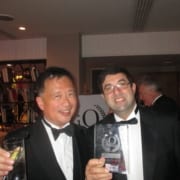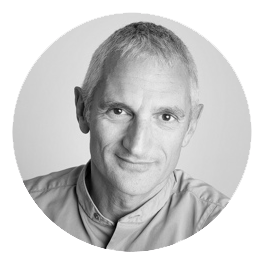Dr. Raymond Perrin – Chronic Fatige Syndrome in BOA
Article supplied with kind permission of the BOA publication ‘Osteopathy Today’, June 2010, Vol.16.5., Author Theresa Devereux
“I have seen this treatment approach work again and again and again – ME is a
terrible illness but it’s just waiting for osteopathy to show what we can do.”
In the spotlight with Dr Raymond Perrin
Dr Raymond Perrin is a Manchester-based osteopath who has come to prominence for his
work with Myalgic Encephalomyelitis (ME) otherwise known as Chronic Fatigue Syndrome
(CFS). He qualified from the BSO in 1984 and for the last 21 years has dedicated himself to
the research of ME and the development of a system of manual diagnosis and treatment
which he claims has helped hundreds of patients and cured many.
He has established a Fund for The Osteopathic Research into ME (F.O.R.M.E) which has raised
over £250,000 and in 2005 was awarded a Doctorate by The University of Salford for his thesis
on CFS/ME.
In 2007 Raymond published a book – The Perrin Technique – How to Beat Chronic Fatigue
Syndrome/ME (1) and his work is being taken seriously by the medical profession. Last year he
made presentations to The International Association of CFS/ME in Reno, Nevada, the World
Congress of Psychosomatic Medicine in Turin and the First World Congress of Neurobiology and
Psycho-pharmacology in Greece.
Raymond, how did your journey with ME start?
At the end of the eighties I was heavily involved in sports medicine and was treating a top cyclist
who had been out of the saddle for 7 years because he had ME. He came in with a back problem
which I treated and explained to him that I couldn’t do very much for his ME – at that time it
was known as yuppie flu and considered very much a psychological problem. His back problems
settled down and rather unexpectedly so did his ME to the extent that within a few months he
had no symptoms at all. He was convinced it was down to my treatment so I thought: well if I
have helped him, how have I? And that’s what started me on this quest.
Considerable controversy surrounds the cause of ME and there is no generally accepted theory
– what do you believe is happening?
There are many theories about ME – some with good evidence – and I think what I’ve done is
bring many of those theories together. I believe the key lies in a problem of the drainage system
of the brain and CNS – a system which most of the medical world have no idea exists. Drainage
of the waters of the brain into the lymphatic system is something Still and Sutherland talked
about and recent work at Southampton University has proved the system does exist – in fact
they are currently looking at it as a possible root cause of Alzheimer’s.
So how does drainage of cerebro spinal fluid into the lymphatic system occur?
There is no true lymphatic system in the CNS but CSF drains through peri-vascular spaces in the
cranium around the optic, trigeminal, auditory and particularly the olfactory nerve through the
cribiform plate in the ethmoid bone and into the lymph. It also drains into the paraspinal
lymphatics via the peri-vascular spaces that lie along the spine.
I believe what is happening in ME is that the drainage system stops working and therefore you
get a build up of toxins in the brain that can’t drain out through any other method. It can be
caused by a structural problem in the spine – trauma, developmental or even a congenital
weakness. But mostly the cause is a disturbance of the afferent sympathetic supply and you find
all ME suffers have a long history of sympathetic overload either emotional, physical, postural,
environmental or immunological for many years preceding the onset of symptoms. With all ME
patients there is a definite weakness in the cranial rhythmic impulse and all have problems in
the thoracic spine greater than the norm.
What is the mechanism by which the flow malfunctions?
The sympathetic nervous system, the thoracic duct, the diaphragm, the lymphatic system and
the hypothalamus all have a role. It would take too long to explain here but in summary
overstimulation of the sympathetics can cause the thoracic duct to pump lymph the wrong way,
away from the main drainage point at the subclavian vein, and back into the lymph system. This
can damage the lymph vessels and valves to the extent that it can cause a flow of lymph back
into the CNS. There’s a build up then of poisons in the brain to which the hypothalamus is
particularly vulnerable (because it is not protected by the blood:brain barrier) so it becomes
irritated – dysfunctional and as controller of the sympathetic nervous system causes further
over-stimulation of the sympathetics.
Where do those toxins in the brain come from?
Those toxins can often be post-infection or inflammatory and notably involve large protein
molecules called cytokines which are produced in response to a virus, other infection or
inflammation and have been linked to ME for years. Some toxins can enter the body in the form
of pollutants such as organophosphates used in pesticides. Also neurochemical changes due to
too much stress can become toxic to the central nervous system.
Is there any evidence in patients of this backflow?
That backflow is seen physically and felt physically by the presence of varicose lymphatics which
we have been trying to prove exist. You feel this in every single patient who has ME and in a few
cases you can see them – in fact I’ve produced the very first picture of a varicose lymphatic which
you can see in my book. We’ve tried to scan them but that’s been unsuccessful because
lymphatics are very difficult to scan.
What do they feel like?
Very specific, not just a lump or bump but a series of lumps and bumps going in one direction
like a chain going along a vessel. The skin overlying is a normal colour.
You have observed a 5-sign diagnostic criteria for ME … can you explain?
I’ve come up with five signs that are all always present in all ME patients. They are:
– Varicose lymphatics
– Perrins point – which is sensitivity to gentle pressure at a point slightly superior and lateral to
the left nipple due to sensory crossover from sympathetic nerve irritation in both the lymphatic
vessels plus the cardiac plexus.
– Coeliac plexus tenderness
– Longstanding thoracic spinal problems with tenderness at T4/T5/T6 segments
– Disturbance of the regular sacro/cranial rhythm.
This diagnostic criteria is about to be researched formally and you’ve just received a
commendation from the local NHS research ethics committee?
Yes, it’s a combined project with North Manchester General Hospital and the University of
Central Lancashire and we have some very good people on board including the Consultant
Rheumatologist in charge of the Fatigue Clinic, a Professor of Physiotherapy, the Head of
Statistics at the University and a Professor of Bio-engineering. It will be a blinded comparative
study comparing my diagnostic criteria with the current conventional approach to diagnosing
ME.
Currently ME is diagnosed by exclusion which involves an exhaustive and expensive process of
tests and examinations to rule out other causative diseases – anaemia, hormonal problems,
myasthenia gravis, glandular fever etc.
If we can prove that my criteria is as reliable as the conventional approach in the diagnosis of
ME we will have a good case to present to NICE for integration into the NHS based on
effectiveness and cost savings. If we are successful it could really open the door for more
funding for more extensive research into my treatment approach
What research have you already done to back up your hypothesis?
My first paper was published in the British Osteopathic Journal in 1993 (2) which led to my first
clinical trial with Professor Jack Edwards, a world-renowned bio-engineer and Dr Pat Hartley, a
leading health psychologist published in The Journal of Medical Engineering and Technology(3) in
1998. The aim was to evaluate the effectiveness of osteopathic treatment on symptoms
associated with ME and the results were positive. It received world-wide interest although the
scientific community were critical of the fact that we didn’t use double-blind randomly
controlled trials. There were faults in the research – the sample numbers were not as big as we
wanted because funding is always a problem and it was not randomised as much as it should
have been but the main thing is it showed a very high success rate.
The second clinical trial looked at the possible mechanisms for improvement – what are we
actually doing physiologically and anatomically in the treatment? It hasn’t been fully published
but last year I presented the paper to The International Association of CFS/ME in Reno, Nevada
and a paper on the MR imaging from this second study has just been published in the British
journal of Radiology.(7)
How seriously is your work being taken?
A lot of the research into ME has been directed at looking at a viral cause – the thinking is more
on the infectious or psychological side and the structural/mechanical side is largely ignored.
The general trend in the ME associations is that they don’t like supporting one particular
treatment approach and GOsC has a rule that they don’t support one particular osteopath.
However I do receive referrals from GPs and some specialists who over the years have seen
many of their patients improve with my technique. Also the PCTs’ online magazine Primary Care
Today ran an article on my work a few years ago with some PCTs funding patients’ treatment.
And I’ve had some interesting recognition from government. The Gibson enquiry, an all-party
review into ME in 2007, was interested in my work and the final report mentioned my diagnostic
criteria as something worthy of future research because of its potential as a very simple and
cost-effective way of diagnosing ME.
Can you tell me something of your treatment approach?
The theory and treatment has been an evolution over the years of noticing common patterns in
ME patients and finding things that worked and stopping and asking why? I started looking at
ME very much as a spinal problem then became aware of the lymphatic involvement but found
that a lot of the traditional lymphatic drainage techniques made patients worse.
The treatment involves simple effluage techniques directed toward the subclavian veins. I work
on the paraspinal muscles relaxing off the soft tissue to reduce the general tone and
sympathetic tone. Some work on the diaphragm and cranial work to open up the drainage
pathways for CSF and to get the rhythm going in a functional passive way.
We offer supplements – vitamins and minerals, Evening Primrose Oil and an Omega-3 fatty acid
– EPA (eicosapentaenoic acid) which have both been shown to speed up healing of the cell
membranes in the brain that are damaged by the toxic chemistry.
On diet, after years of experience, I recommend a rotation diet – eat lots of different types of
food, reduce the dairy and wheat but don’t cut it out altogether – eat a little bit of everything
with small regular meals preferred.
There is a mind element so you find NLP (Neuro Linguistic Programming) or EMDR (Eye
Movement Desensitisation and Reprocessing) can help but ME is much more than just a
psychological problem.
Lifestyle changes are important and I prescribe regular specific exercises and self-massage to
back up the osteopathic treatment.
What success rate do you have with patients?
We help about 90% of patients that come to us and I would say we can discharge about 30% as
fully cured. 70% need other things as well – the problem lies in patients who continually produce
further toxins or are in an environment where there’s a lot of toxicity or a lot of stress-producing
chemical changes which are toxic or they have a chronic infection or inflammation that can go
on and on.
There are some who just don’t follow instructions and there are a few whose symptoms are so
severe they might need a lot of other treatment before they start with us. Sometimes they are
not still suffering from ME but the effects of having ME for so long and major disease is setting
in.
But I have seen this treatment approach work again and again and again – ME is a terrible
illness but it’s just waiting for osteopathy to show what we can do.
….but will osteopathy be able to? How are the current advertising restrictions affecting you?
Last year I attended a meeting at the GOsC where a group of us discussed scope of practice
within the profession. I told the meeting that osteopathy has to expand beyond the joint and
muscular ailments to allow future research into other conditions that may benefit from our
techniques. As long as ethically approved research has taken place and that the treatment is
evidence-based I think we as a profession should shout loud and clear from the rooftops
about the range of conditions we can help without claiming miracle cures! Let the scientific
argument do the talking.
With sincere thanks to Dr Raymond Perrin DO.
www.theperrinclinic.com
www.meassociation.org.uk
(1) The Perrin Technique – how to beat chronic fatigue syndrome/ME by Dr Raymond
Perrin www.hammersmithpress.co.uk
(2) Perrin R,N. 1993 Chronic Fatigue Syndrome, a review from the biomechanical
perspective, British Osteopathic Journal; vol xi.
(3) Perrin RN, Edwards J and Hartley P (January/February 1998) an evaluation of the
effectiveness of osteopathic treatment on symptoms associated with myalgic
encephalomyelitis. A preliminary report. Journal of Medical Engineering and
Technology, 22(1), 1-13
(4) Perrin RN. Lymphatic Drainage of the Neuraxis in Chronic Fatigue Syndrome: A
Hypothetical Model for the Cranial Rhythmic Impulse. Journal of the American
Osteopathic Association, 107(06), 218-224. 2007
(5) Perrin R, Tsaluchidu S. Integrating biological, psychological and sociocultural variables in
myalgic encephalomyelitis: onset, maintenance and treatment. Panminerva Medica
51(03) Suppl. 1, 88, Sept 2009
(6) Perrin R. EPA and The Perrin Technique: A combined approach to treating myalgic
encephalomyelitis. Annals of General Psychiatry. 9 (Supplement 1):S25, 2010
(7) Perrin R, Embleton K, Pentreath VW, Jackson A. Longitudinal MRI shows no cerebral
abnormality in chronic fatigue syndrome. Br J Radiol. 2010 May;83(989):419-23





Leave a Reply
Want to join the discussion?Feel free to contribute!